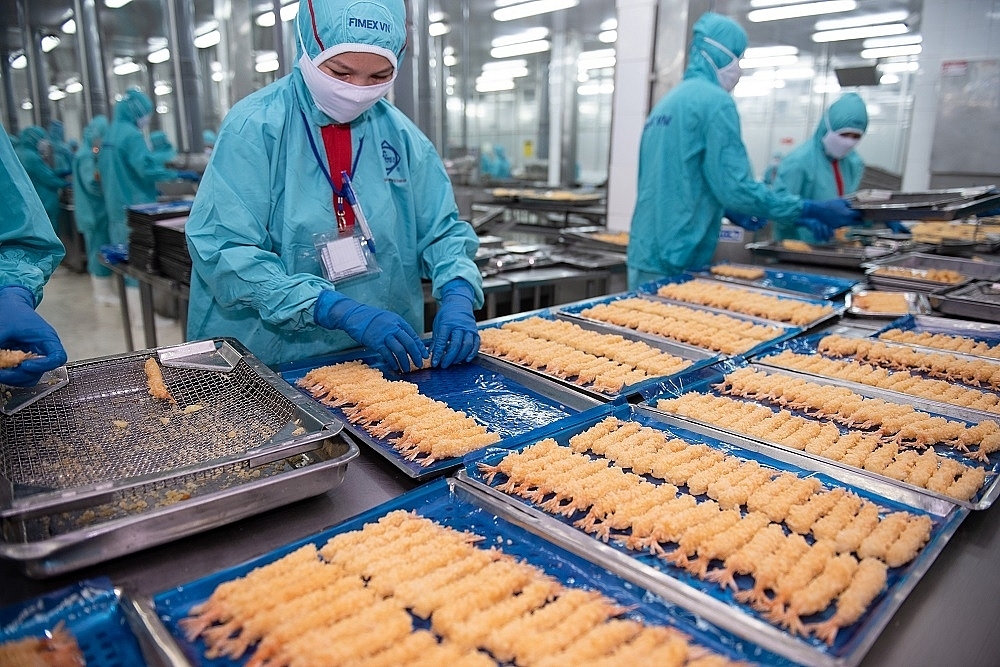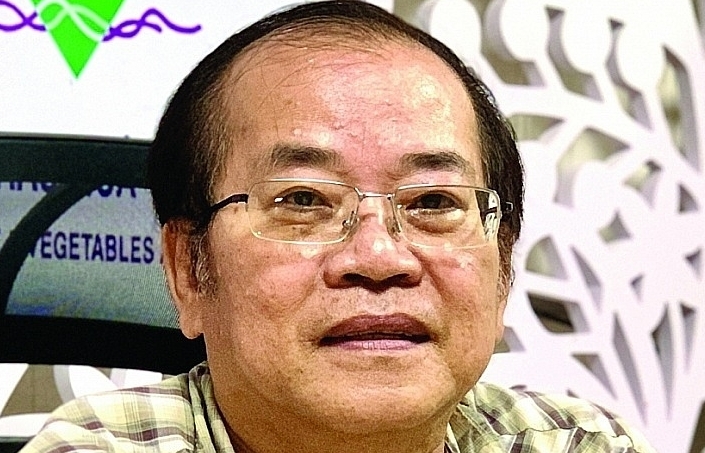Exporting shrimp businesses propose solutions to enhance competitiveness in the market
| Australia is second-largest shrimp import market of Vietnam in CPTPP | |
| Shrimp exporters focus on added value | |
| Shrimp industry optimises advantages for development |
 |
| Processing shrimp for export at Sao Ta Food Joint Stock Company. |
As one of the largest shrimp exporting companies, Mr Le Van Quang, CEO of Minh Phu Seafood Corporation, believes that Vietnam's shrimp industry has lost VND 10 trillion due to the habit of using antibiotics in shrimp farming by residents. This includes the costs companies must spend on checking and controlling antibiotics from the farming areas to the processing plants. This has been a high cost for decades, including the cost of checking antibiotics in importing countries, which companies must bear and deduct from the selling price.
Along with that, the opportunity to sell is significantly reduced due to extended customs clearance time as samples need to be taken and waiting for antibiotic test results, which reduces the competitiveness of shrimp.
With the high cost, the cost of raw shrimp in Vietnam is 30% higher than that of India and twice that of Ecuador, making Vietnamese shrimp less competitive than those of other countries.
According to Mr Phu, shrimp is the main export commodity of Vietnam's seafood industry, accounting for 40-45% of the total seafood export turnover annually. Therefore, to develop the fisheries industry, more emphasis should be placed on developing shrimp farming, including from the stages of cultivating raw materials to processing and exporting, helping Vietnamese shrimp compete well in the world market.
To enhance the competitiveness of Vietnamese shrimp in the international market, Mr Le Van Quang proposed some recommendations.
The Government should take a strong stance on antibiotics and continuously and regularly check antibiotics in farming areas. If antibiotics are detected, the shrimp ponds should be immediately closed to stop local residents' habit of using antibiotics. In addition, strictly control and handle companies and sellers of drugs, chemicals, and microbial products, revoke business licenses, and handle criminal cases if antibiotic mixing is detected.
The Government allows the establishment of a public-private partnership mechanism between businesses and research institutes, including the Research Institute for Aquaculture II, to support businesses in the aquaculture sector.
Specifically, improving the genetics of parent black tiger shrimp and white leg shrimp to produce high-quality shrimp seeds that are resistant and adaptable to diseases, weather, climate, and environments in each region of Vietnam. Producing high-quality disease-resistant and climate-adapted shrimp seeds for each region of Vietnam will increase the success rate of Vietnam's shrimp farming industry to over 60% by 2030 and over 80% by 2035 (currently, the success rate of Vietnam's shrimp farming is below 40%).
Developing and perfecting models for farming black tiger shrimp in mangroves, intensive white leg shrimp farming, semi-intensive white leg shrimp farming, shrimp-rice farming, semi-intensive white leg shrimp farming, intensive white leg shrimp farming, and super-intensive white leg shrimp farming with low cost suitable for each region of Vietnam.
With the above solutions, if Vietnam implements them this year, the cost of Vietnamese shrimp will be equivalent to Indian shrimp before 2030 and Ecuadorian shrimp before 2035, helping shrimp farmers become wealthy on their land and enabling processing and export businesses to make better profits to build a strong and sustainable shrimp industry.
Agreeing with the above view, Mr Ho Quoc Luc, Chairman of the Board of Directors of Sao Ta Food Joint Stock Company, also stated that it is necessary to consider standardizing production facilities, supplying shrimp seeds such as production capacity (factories, ponds, etc.), and parent shrimp to maintain uniform seed quality and minimize risks for farmers. "Ecuador and Thailand have fewer than ten shrimp seed production units, making it easier to manage shrimp seed. But, on the other hand, we have over 2,000 supply units, which are difficult to manage, and the past has shown that floating, cheap, and low-quality shrimp seeds have resulted in a very low success rate, causing the cost of shrimp farming to increase," Mr Luc said.
In addition, it is necessary to plan land for shrimp farming, and sustainable development and animal welfare trends will limit the high-density semi-intensive shrimp farming. Therefore, a strategy for allocating additional land for shrimp and catfish farming is needed if we want to maintain and increase production.
To meet the demands of large markets, it is necessary to increase the number of farms that meet the ASC standard. Currently, the percentage of farms that meet the ASC standard is very low, less than 1% of the total area used for farming, while in Ecuador, this percentage is 20%. Shrimp production dominates the EU market, where this standard is very popular. The reason for this is that the shrimp farming industry in Vietnam is weak, small-scale, and difficult to meet the requirements.
The solution to overcome this situation is to encourage investors to accumulate land to form larger farms for shrimp farming. The larger the farms, the more conducive investing in scientific technology to reduce costs and increase competitiveness.
Related News

Complying with regulations of each market for smooth fruit and vegetable exports
13:06 | 09/01/2025 Import-Export

Coconut export enter acceleration cycle
11:02 | 30/12/2024 Import-Export
Latest News

Việt Nam tightens fruit inspections after warning from China
08:01 | 15/01/2025 Import-Export

Brand building key to elevate Vietnamese fruit and vegetable sector: experts
08:00 | 15/01/2025 Import-Export

Freight transport via China-Việt Nam cross-border trains posts rapid growth
08:01 | 13/01/2025 Import-Export

Vietnamese retail industry expects bright future ahead
06:22 | 11/01/2025 Import-Export
More News

Fruit and vegetable industry aims for $10 billion in exports by 2030
15:12 | 07/01/2025 Import-Export

GDP grows by over 7 per cent, exceeds target for 2024
15:11 | 07/01/2025 Import-Export

Vietnamese pepper: decline in volume, surge in value
15:10 | 07/01/2025 Import-Export

Việt Nam maintains position as RoK’s third largest trading partner
15:09 | 07/01/2025 Import-Export

Greater efforts to be made for stronger cooperation with European-American market
15:08 | 06/01/2025 Import-Export

Leather, footwear industry aims to gain export growth of 10% in 2025
15:06 | 06/01/2025 Import-Export

Grasping the green transformation trend - A survival opportunity for Vietnamese Enterprises
14:53 | 06/01/2025 Import-Export

Việt Nam to complete database of five domestic manufacturing industries in 2026
20:57 | 05/01/2025 Import-Export

Logistics firms optimistic about growth prospects in 2025: Survey
20:54 | 05/01/2025 Import-Export
Your care

Việt Nam tightens fruit inspections after warning from China
08:01 | 15/01/2025 Import-Export

Brand building key to elevate Vietnamese fruit and vegetable sector: experts
08:00 | 15/01/2025 Import-Export

Freight transport via China-Việt Nam cross-border trains posts rapid growth
08:01 | 13/01/2025 Import-Export

Vietnamese retail industry expects bright future ahead
06:22 | 11/01/2025 Import-Export

Complying with regulations of each market for smooth fruit and vegetable exports
13:06 | 09/01/2025 Import-Export
